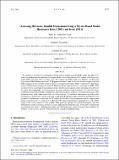Assessing Hurricane Rainfall Mechanisms Using a Physics-Based Model: Hurricanes Isabel (2003) and Irene (2011)
Author(s)
Lu, Ping; Lin, Ning; Smith, James; Emanuel, Kerry Andrew; Chavas, Daniel Robert
Downloadjas-d-17-0264.1.pdf (4.083Mb)
PUBLISHER_CC
Publisher with Creative Commons License
Creative Commons Attribution
Terms of use
Metadata
Show full item recordAbstract
We examine a recently developed physics-based tropical cyclone rainfall (TCR) model and apply it to assess the mechanisms that dominate the magnitude and spatial distribution of TC rainfall, with Hurricanes Isabel (2003) and Irene (2011) as study cases. We evaluate the TCR model using Weather and Research Forecasting (WRF) Model simulations. TCR-generated rainfall fields for the two storms compare well with WRF estimates in terms of both azimuthal mean and spatial distributions. When coupled with a hydrologic model, TCR generates flood peaks over the Delaware River basin for Irene as accurately as WRF. TCR accounts for four major rainfall mechanisms: surface frictional convergence, vortex stretching, interaction of the storm with topography, and interaction of the storm with large-scale baroclinity. We show that these rainfall mechanisms affected the rainfall pattern differently for Isabel and Irene. Frictional convergence is the dominant factor, while other mechanisms are also significant. The frictional convergence depends on the boundary layer formulation, which is relatively simple in TCR and may require calibration of boundary layer parameters. Furthermore, we find that the TC rainfall distribution is strongly dependent on the temporal and spatial variation of the TC wind field, mediated by the physical mechanisms represented by TCR. When coupled with various analytical wind models, TCR generally captures the rainfall distribution, with the Holland wind model performing the best. Given its high computational efficiency, TCR can be coupled with an analytical wind model, a hydrological model, and a TC climatology model to generate large numbers of synthetic events to assess the risk associated with TC rainfall and inland flooding. Keywords: Rainfall; Tropical cyclones
Date issued
2018-06Department
Massachusetts Institute of Technology. Department of Earth, Atmospheric, and Planetary SciencesJournal
Journal of the Atmospheric Sciences
Publisher
American Meteorological Society
Citation
Lu, Ping et al. “Assessing Hurricane Rainfall Mechanisms Using a Physics-Based Model: Hurricanes Isabel (2003) and Irene (2011).” Journal of the Atmospheric Sciences 75, 7 (July 2018): 2337–2358 © 2018 American Meteorological Society
Version: Final published version
ISSN
0022-4928
1520-0469